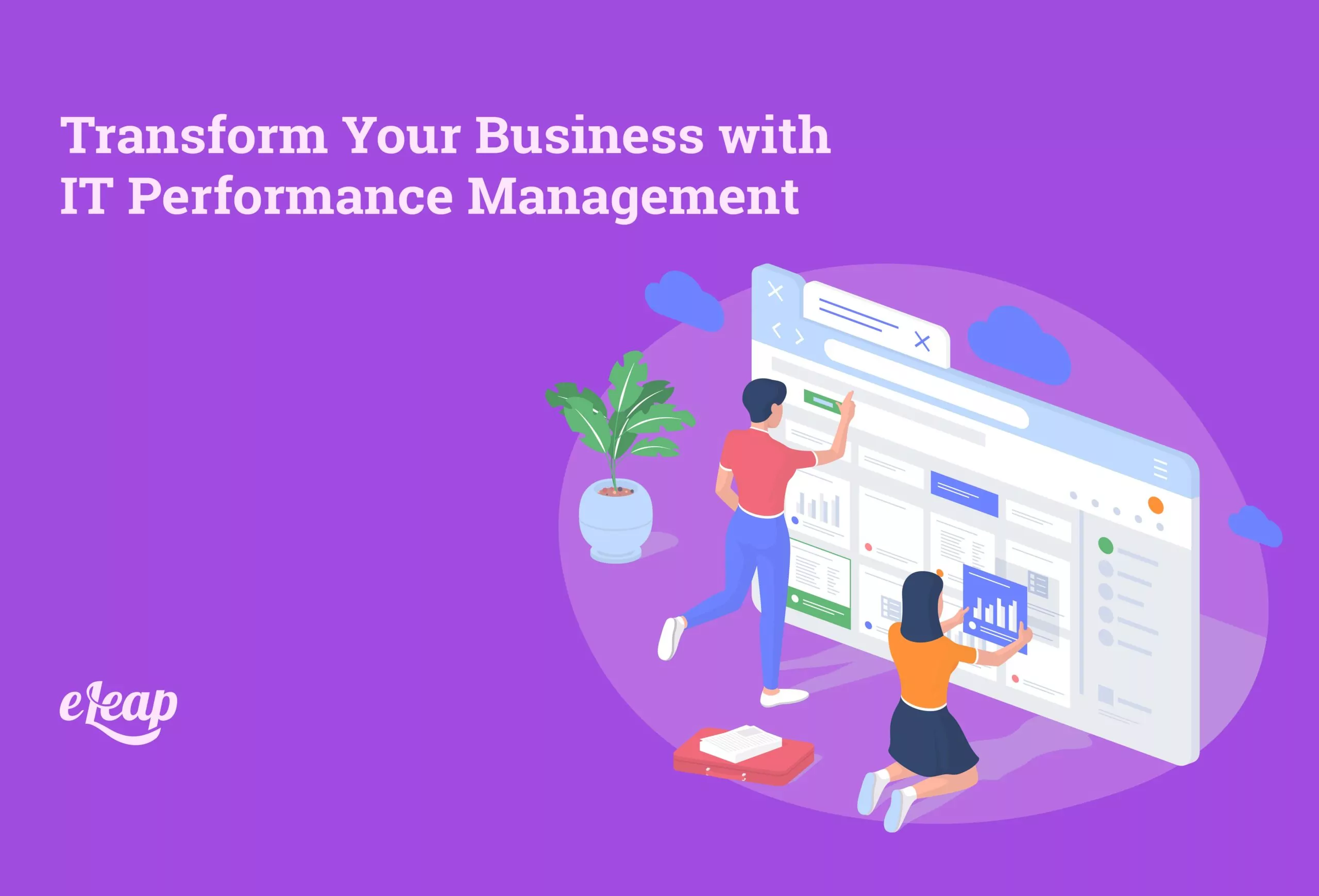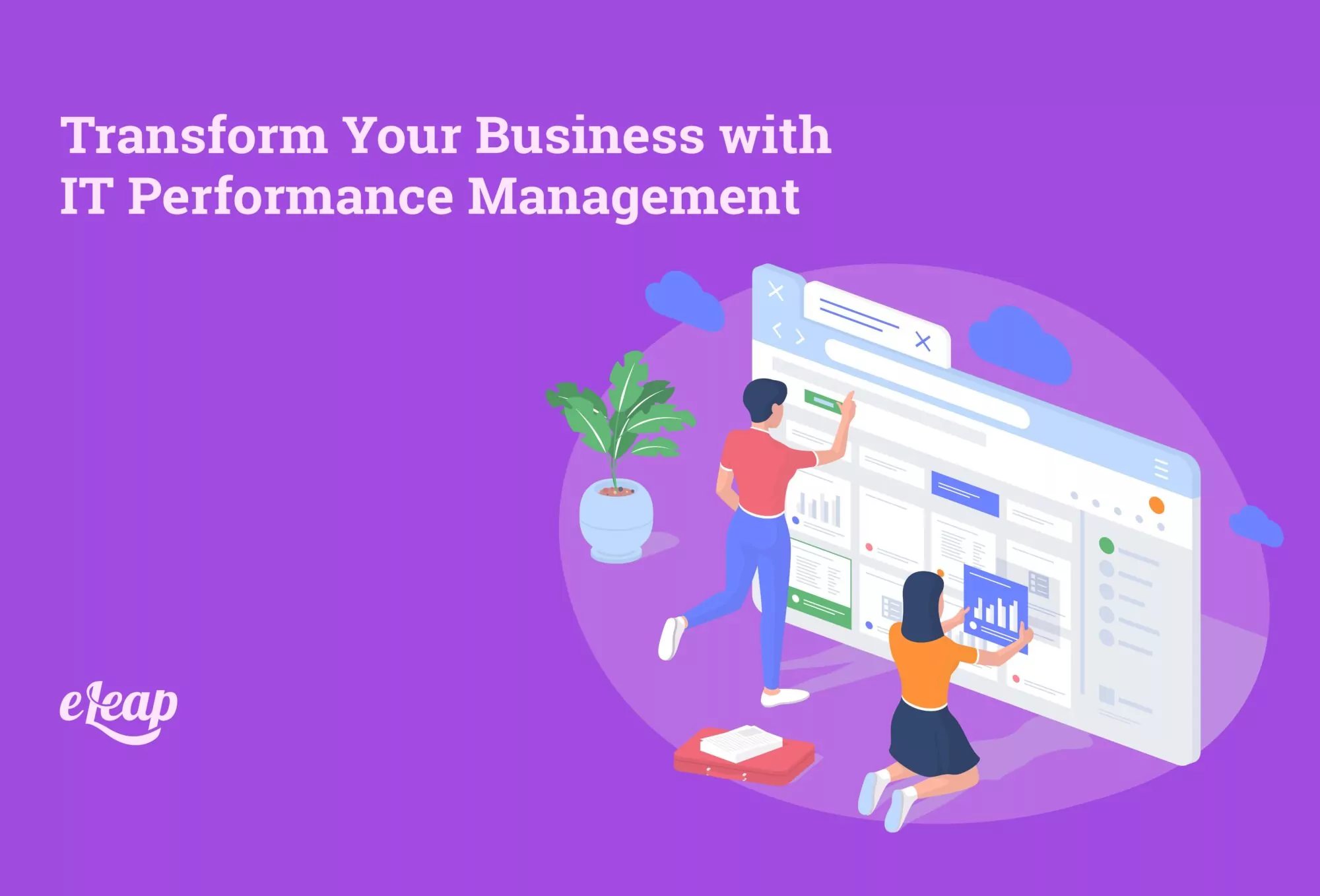Transform Your Business with IT Performance Management

Businesses rely heavily on IT infrastructure to operate smoothly in the digital age. However, IT performance can often become a bottleneck, hindering overall productivity and growth. IT Performance Management (ITPM) is a solution designed to optimize IT systems, ensuring they run efficiently and align with broader business goals. By continuously monitoring, measuring, and refining IT systems, businesses can gain better control over their technology, reduce costs, and improve service delivery. This article will explore the significance of IT Performance Management, its core components, best practices, and real-world examples of businesses benefiting from these practices. See how eLeaP®’s Performance Management Platform helps you apply these insights to drive better results.
Why IT Performance Management is Crucial for Your Business
What is IT Performance Management?
At its core, IT Performance Management involves monitoring and improving the performance of an organization’s IT infrastructure, applications, and systems. By continuously tracking key metrics and analyzing data, businesses can ensure their IT environment functions optimally and supports business objectives. ITPM aims to improve system reliability, reduce downtime, enhance user experience, and enable faster decision-making. Through this process, businesses are better positioned to meet the demands of customers and stakeholders while simultaneously lowering operational costs.
The Critical Role of IT in Business Operations
IT is no longer just a support function in most organizations. It is the backbone of business success, facilitating communication and enabling complex business processes. With the rise of cloud computing, mobile technologies, and remote working, IT systems must be agile, secure, and robust. Effective IT performance management ensures that these systems meet business demands, providing a seamless experience for employees and customers alike.
How Effective IT Performance Management Drives ROI
Investing in IT Performance Management is not just about keeping systems running smoothly; it’s about generating a tangible return on investment. By improving system uptime, businesses can avoid costly disruptions that impact productivity. ITPM tools also help identify inefficiencies, leading to cost reductions in hardware and software resources. Additionally, the insights gained from performance data can guide strategic decisions, ensuring investments are made in areas that deliver the most significant business value.
Key Benefits of IT Performance Management
Streamlining Operations for Peak Efficiency
When IT systems are properly managed, organizations experience streamlined operations. Downtime, which can result in lost productivity and revenue, is minimized. With constant monitoring, businesses can identify issues before they escalate into significant problems. As a result, teams spend less time troubleshooting and more time focusing on their core tasks. This process leads to a more efficient workforce, ultimately contributing to the organization’s success.
Reducing IT Costs and Optimizing Resource Allocation
IT costs can quickly spiral out of control without effective performance management. By continuously monitoring IT performance, businesses can uncover areas where resources are underutilized or wasted. This stage might include redundant software, inefficient hardware, or underperforming systems. With ITPM, organizations can optimize their infrastructure, shifting resources to where they are needed most. For example, consolidating IT services through cloud solutions can lower hardware and maintenance costs, freeing up capital for other strategic investments.
Data-Driven Decision-Making for Strategic Business Growth

One of the most significant advantages of IT Performance Management is the ability to leverage data for informed decision-making. As businesses collect performance metrics, they can analyze trends, identify patterns, and forecast future needs. This data-driven approach helps organizations make decisions that align with their business objectives. Whether deciding on new technology investments or reallocating IT budgets, the insights gained from ITPM ensure that decisions are based on accurate, real-time data rather than assumptions.
Enhancing Customer Experience with Seamless IT Services
In today’s fast-paced market, customers expect rapid and uninterrupted service. They also expect their business interactions to be smooth and seamless, whether shopping online, using financial services, or using cloud-based tools. IT Performance Management is crucial in ensuring that businesses can meet these expectations. By optimizing IT systems and monitoring performance, companies can provide faster response times, more reliable services, and a better customer experience. A positive customer experience directly translates into greater customer loyalty and, ultimately, higher revenue.
The Core Components of IT Performance Management
Key IT Metrics to Track
Effective IT Performance Management requires a set of specific metrics to track, analyze, and improve performance. These include system uptime, response times, error rates, and throughput. System uptime, for example, is one of the most critical metrics. It measures the time a system is operational and available for use. Downtime directly impacts productivity, so ensuring maximum uptime is crucial. Similarly, response times measure how quickly a system responds to user requests, which is especially important for web-based services and e-commerce platforms.
Another vital metric is resource utilization, which tracks how efficiently hardware and software resources are used. Inefficient resource use can indicate that a system is underperforming, leading to unnecessary costs. By monitoring these key metrics, businesses can identify potential issues before they affect performance.
Leading Tools for IT Performance Monitoring
Various tools are available to help businesses monitor and manage their IT performance. Platforms like eLeaP offer robust solutions for performance tracking, allowing companies to monitor key metrics in real-time. Other well-known tools include SolarWinds, Datadog, and New Relic, which provide potent dashboards, real-time alerts, and automated reports to keep IT systems on track.
These tools integrate with a business’s IT infrastructure to view system performance comprehensively. They help IT teams identify slowdowns, bottlenecks, and other performance issues before they become significant problems. By leveraging these tools, businesses can ensure they are operating at peak efficiency and can quickly address any performance gaps that may arise.
Processes to Optimize IT Operations and Systems
It’s not just about the tools but also the processes in place to optimize IT performance. Regular maintenance, patch management, and system updates are crucial components of IT operations. A proactive approach to performance management means identifying and addressing potential issues before they affect service delivery. For example, scheduling regular system audits allows businesses to identify outdated software or hardware affecting performance.
Incorporating automated solutions also plays a key role in optimizing IT operations. Automation tools can handle routine tasks, such as software updates or server provisioning, freeing IT teams to focus on more strategic initiatives. This step ensures that IT performance is consistently high without requiring constant manual intervention.
Best Practices for IT Performance Management
Set Clear, Aligned IT and Business Goals
For IT performance management to be effective, it must align with overall business objectives. Setting clear and measurable IT goals ensures that performance management efforts are directed toward outcomes that matter. For instance, a business might set a goal to reduce IT-related downtime by 30% over the next year. By linking IT goals to business goals, companies can better understand how IT performance contributes to the organization’s success.
Implement Continuous Monitoring and Regular Audits
Continuous monitoring ensures that IT systems are always performing at their best. This process allows businesses to detect and address issues early before they escalate. Regular audits also help ensure that systems are up-to-date, secure, and compliant with industry standards. Implementing a regular review process helps businesses stay ahead of potential problems and maintain the health of their IT infrastructure.
Create a Culture of Continuous Improvement
IT performance management is not a one-time initiative but an ongoing process. To maintain optimal performance, businesses should foster a culture of continuous improvement. IT teams should regularly review performance metrics and strive to make improvements. This culture of improvement can be supported by training programs that ensure employees are up-to-date with the latest technologies and best practices.
Ensure Cross-Department Collaboration for IT Success
IT is no longer the sole responsibility of the IT department. As businesses rely more heavily on technology, IT performance management requires department collaboration. Marketing, operations, and finance teams should all have a vested interest in ensuring IT systems are performing well. A collaborative approach ensures that various departments’ needs are met and IT performance is aligned with broader business objectives.
Real-World Examples: How Businesses are Transforming with IT Performance Management
Case Study 1: Retail Business Improving Operational Efficiency
A major retail chain implemented IT performance management practices to optimize its online store and back-end systems. Using performance monitoring tools, they identified and addressed performance bottlenecks, reducing site downtime during peak traffic. As a result, the business saw improved customer satisfaction, higher conversion rates, and increased revenue.
Case Study 2: Financial Institution Enhancing Customer Experience
A large financial institution adopted IT performance management strategies to improve its customer-facing platforms. By optimizing server performance and reducing transaction processing times, the institution could provide its clients with faster, more reliable services. This enhanced customer experience, improved client retention, and attracted new customers.
Case Study 3: Healthcare Provider Ensuring Compliance and Improving IT Systems
A healthcare provider uses IT performance management to ensure their systems comply with industry regulations while optimizing IT resources. By improving performance and ensuring data security, they could meet regulatory requirements without sacrificing service quality. This approach allowed the organization to improve patient care and operational efficiency simultaneously.
The Future of IT Performance Management
Harnessing Artificial Intelligence and Machine Learning for Smarter IT Management
AI and machine learning are set to revolutionize IT performance management. These technologies allow businesses to predict potential issues, enabling proactive measures to prevent downtime or system failures. AI can also automate routine tasks like system monitoring, allowing IT teams to focus on more strategic activities.
The Impact of Cloud Technologies on IT Performance Management
Cloud computing has made it easier for businesses to scale their IT resources as needed. Cloud-based IT performance management solutions offer flexibility and scalability, enabling companies to adapt to changing demands without heavy infrastructure investments.
Conclusion
Effective IT performance management is essential for businesses looking to remain competitive in a technology-driven world. Organizations can streamline operations, reduce costs, enhance customer experiences, and make data-driven decisions that align with business goals by optimizing IT systems. Whether you’re a small business or an enterprise-level organization, adopting a strategic approach to IT performance management is crucial to achieving long-term success.
As businesses embrace technologies like AI, cloud computing, and automation, they can continue to drive growth while ensuring that their IT infrastructure remains efficient and reliable. ELeaP provides tools that help businesses manage IT performance, ensuring their systems are functional and optimized for maximum impact.
Investing in IT performance management today will pay off in greater efficiency, reduced costs, and improved customer satisfaction, setting your business up for success in the digital future.